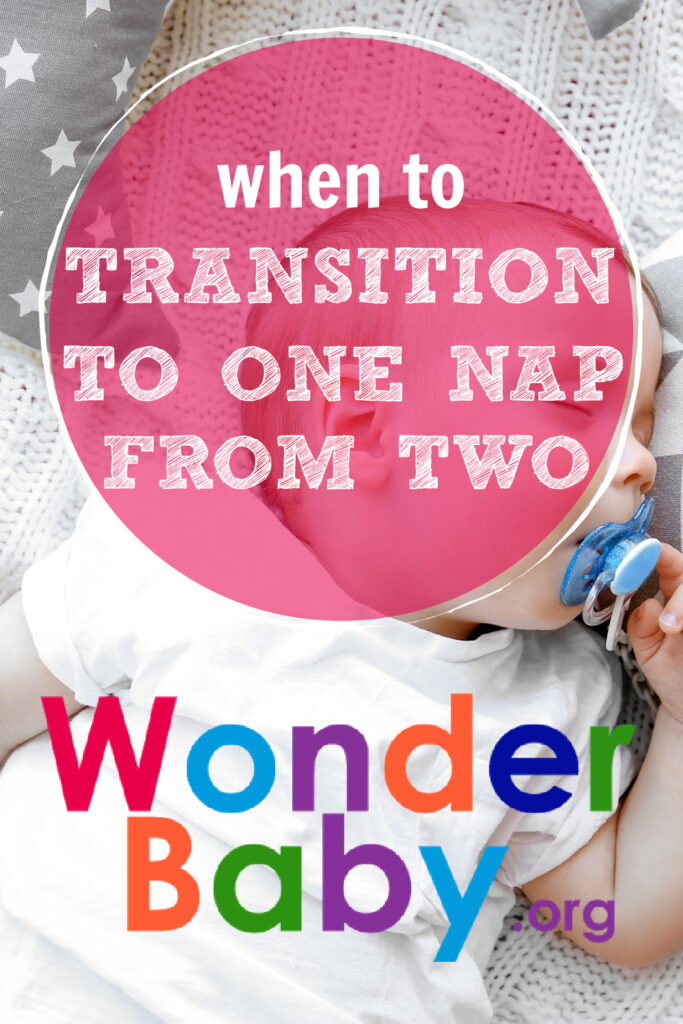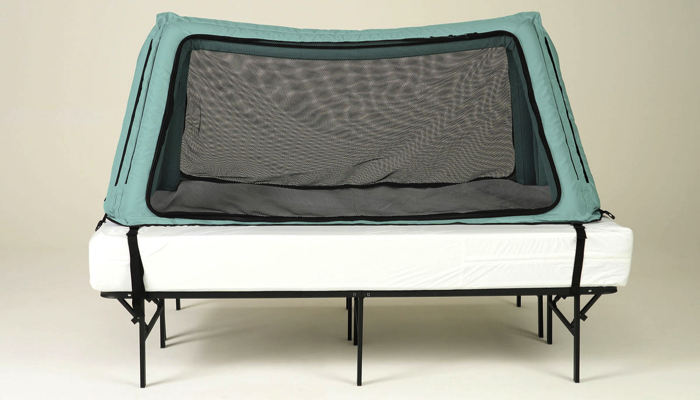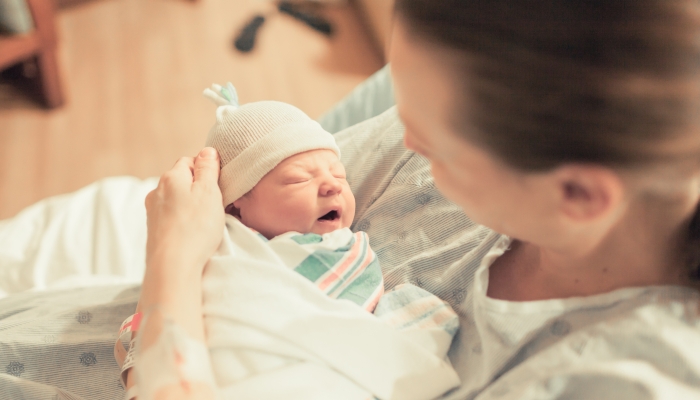When to Transition to One Nap From Two

- Transitioning to one nap from two will happen at different times for different children; however, most children drop to one nap between 14 and 18 months.
- Signs of readiness for dropping to one nap are more important than your child’s age.
- Transitioning to one nap is a slow and gradual process best approached with patience and flexibility.
It was a tale of two nappers in our house when my sons were toddlers.
My older son took an hour nap every morning and a three-hour nap every afternoon well into toddlerhood. Then he’d sleep 11 hours at night.
My younger son, on the other hand, dropped his morning nap at nine months, slept for about 90 minutes in the afternoon, and rarely slept more than ten hours a night. He started many days at 5 am. Even years later, my older boy is a late sleeper, and my younger one is an early riser.
Some children, like some adults, need a lot of sleep. Others just don’t need as much.
When it comes to making the transition to one nap from two, you can’t predict exactly how or when your child will do it. The time for this change will be different for every child and could happen anywhere from just before their first birthday until they turn two and maybe even beyond that.
Why Should You Consider Transitioning Your Child to One Nap?
You should consider transitioning your child to one nap only when they show signs of readiness for the switch. If you attempt to make this change before your child is ready, you risk them becoming overtired during the day and taking short naps. This poor or inconsistent daytime sleep then leads to more wakefulness during the night and early morning wake-ups.
Many children do not naturally experience this change in their sleep patterns until 14 to 18 months, and some still take two naps beyond that age.
Still, you might be concerned about your child fitting in with a nap schedule at their daycare or another childcare situation, making their nap times inconvenient. If that’s the case, talk with your childcare providers about your child’s sleep and how schedules can be adapted to make sure they get the sleep they need.
Getting enough good sleep is essential for children. The American Academy of Pediatrics (AAP) suggests the following sleep times for children under five:
| Age | Hours of Sleep Per 24 Hours, Including Naps |
| 4 to 12 months | 12 to 16 |
| 1 to 2 years | 11 to 14 |
| 3 to 5 years | 10 to 13 |

When Is It Too Early to Drop to One Nap?
There is no “right” age at which a child must drop to one nap. If you try to switch to one nap but find that your child is overtired, grumpy, and falling asleep at other times during the day, you may have dropped to one nap too early.
Signs that it’s too early to drop to one nap include the following:
- Change in mood with increased tantrums.
- Restlessness.
- Waking at night when they didn’t before.
- Refusing to take the remaining naps.
- Taking a short cat nap and falling asleep at inconsistent times during the day.
If your child isn’t ready for the transition, reintegrate their second nap into your daily routine. Then, you can try again when they show signs that they’re ready.
When Is the Best Time to Transition to One Nap?
The average age that most children transition to one nap is between 14 and 18 months. However, the signs that your child is ready to drop a nap are more important than their specific age.
If you think your child is ready to transition, make sure you start during a relatively calm period when your child is not sick or teething. It’s also best to avoid trying the transition if another meaningful change happens, like Mom returning to work or having a new baby in the house.
Signs That Your Child Is Ready to Drop to One Nap
Your child will show signs that it’s time to change from two naps to a one-nap schedule. Keep in mind that nap transitions and changes to daytime sleep can be difficult, even if your child is ready.
Expect some changes to night sleep, including night wakings. As the hours they’re awake, or wake windows, increase, the transition period can take some time.
Signs that your child is ready to go from two naps to one include:
Resisting one nap but taking the other
Your baby may be fighting sleep when they’re put down for their morning nap or flat out refusing to take it. However, they may go down quickly and sleep soundly when it’s their usual afternoon nap time.
This shows they might be ready for more awake time during the day, although they still need one nap to power through.
Fussing, playing, and not sleeping at nap time
You put your child down for either nap of the day, and they fuss, play quietly, remain awake and then only sleep for a short time.
This demonstrates that they may need a one nap transition to consolidate their daytime sleep.
Remaining cheerful and energetic throughout the day
Your child is talkative, cheerful, and has a consistent energy level throughout their usual nap time.
Suppose your child’s mood is stable and happy rather than grumpy for longer periods and during the time that would be their usual morning snooze or afternoon nap. In that case, they are probably ready to drop one.
Your child doesn’t fall asleep during daytime car trips
If your baby can stay awake during daytime car trips, they may be ready to get through the day with one less nap.
Waking up at night or early morning waking
Your child may be going through a sleep regression if they once slept through the night regularly but are now experiencing nighttime wake ups or waking early.
Sleep regressions will occur at various times during a baby’s first two years. They can be caused by illness, teething, or growth spurts. They can also be a sign that your child needs less day sleep. It may be time to get on a one nap schedule.

Guide to Transitioning Your Child From Two Naps to One
Nap transitions will take time; you can expect this change in sleep patterns to take a few weeks before things settle. There may be periods of overtiredness, resistance, early morning wake ups, and crankiness as you transition from two naps to one.
You can do a few things to make this shift easier for your child and you. However, it’s important also to remember that if it’s not working, your child may not be ready. You can go back to two naps and try again at a better time.
Make the change gradually
Some children may simply drop their nap. But most kids will gradually reduce the length of one or both of their naps over a few weeks.
One way to consolidate two naps into one longer nap is to gradually push back the time of the first nap by 15 to 30-minute intervals. Then, extend that time by a few minutes every few days.
It may take several weeks for the nap to disappear. It’s also normal for your child to have a few days of taking both naps. Give it some time, and the change will happen gradually.
Adjust other timings in your daily routine
To avoid overtiredness when your child’s day sleep changes, adjust the timings of other parts of the day as well.
Consider bringing dinner time forward and start their bedtime routine 15 to 30 minutes earlier. Your child may be very tired by the end of the day. To avoid meltdowns and potential trouble getting to sleep because they’re overtired, make bedtime earlier while your child adjusts.
Introduce quiet, restful time
Let’s say your child is skipping their morning nap pretty consistently. It’s still a good idea to introduce a calm, quiet playtime period. Your child is no longer falling asleep, but having a restful break during their old nap time is a good idea.
Continue to offer two naps
In the beginning stages of this transition, there may be days when your child still needs that second nap. Continue to offer your child two naps as they get used to their new schedule. The naps may be shorter, but if your child needs them, that’s okay.
FAQs
Is it okay to wake my baby or toddler from their nap?
If you are a few days or weeks into a nap transition, it’s okay to occasionally wake your child if their nap is running long. If you’re waking your baby regularly, however, it may be a sign that they’re not actually ready to make the transition.
If you don’t want to wake your baby from a nap, consider moving their other nap time or their bedtime to a later time.
You may also want to wake them if they’ve fallen asleep late in the day because of a nap transition. In that case, you may want to bring their bedtime forward so they get to sleep earlier for the night, rather than sleeping during the day.

Related Posts

Sleep, Special Needs
Safe Place Bedding Travel Bed Review
Traveling with a special needs child can be stressful! Having a safe, durable, and easy to use travel bed can make traveling so much easier!

Sleep, Special Needs
Sleep Regimen for Premature Babies: Special Considerations
It can take premature babies much longer than their full-term peers to sleep for long stretches. A preemie sleep schedule may encourage better sleep.

Sleep
Mastering the Bedtime Routine: 3 Tips for a Peaceful Night’s Sleep
From around six weeks, a newborn bedtime routine can help your baby learn the difference between day and night and prepare for a restful night’s sleep.